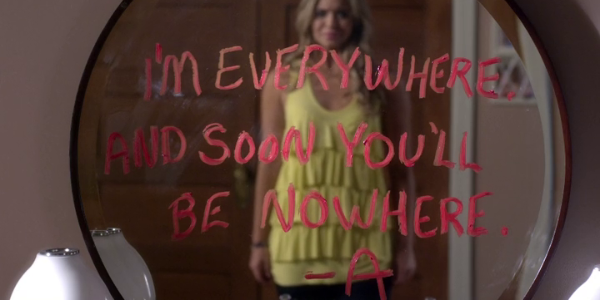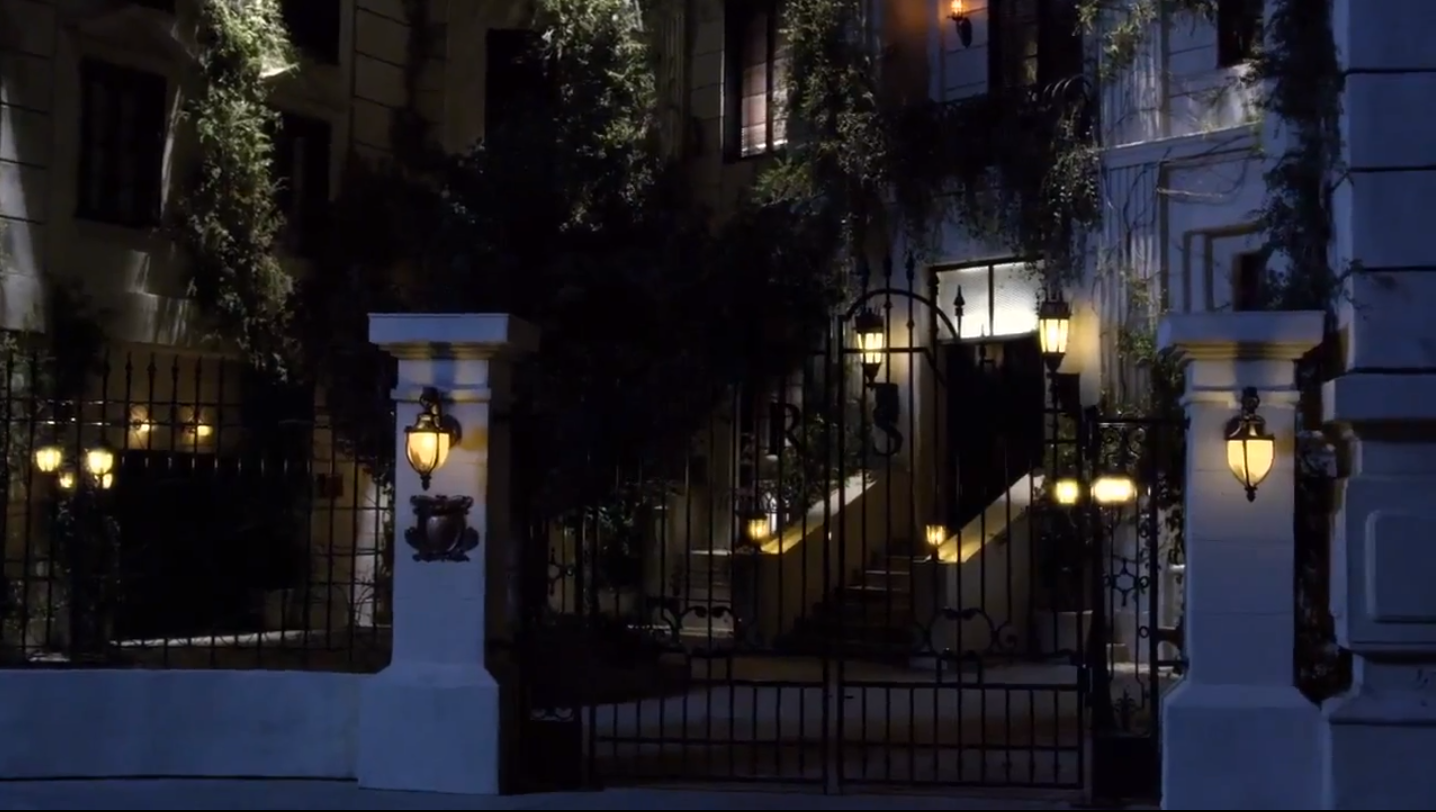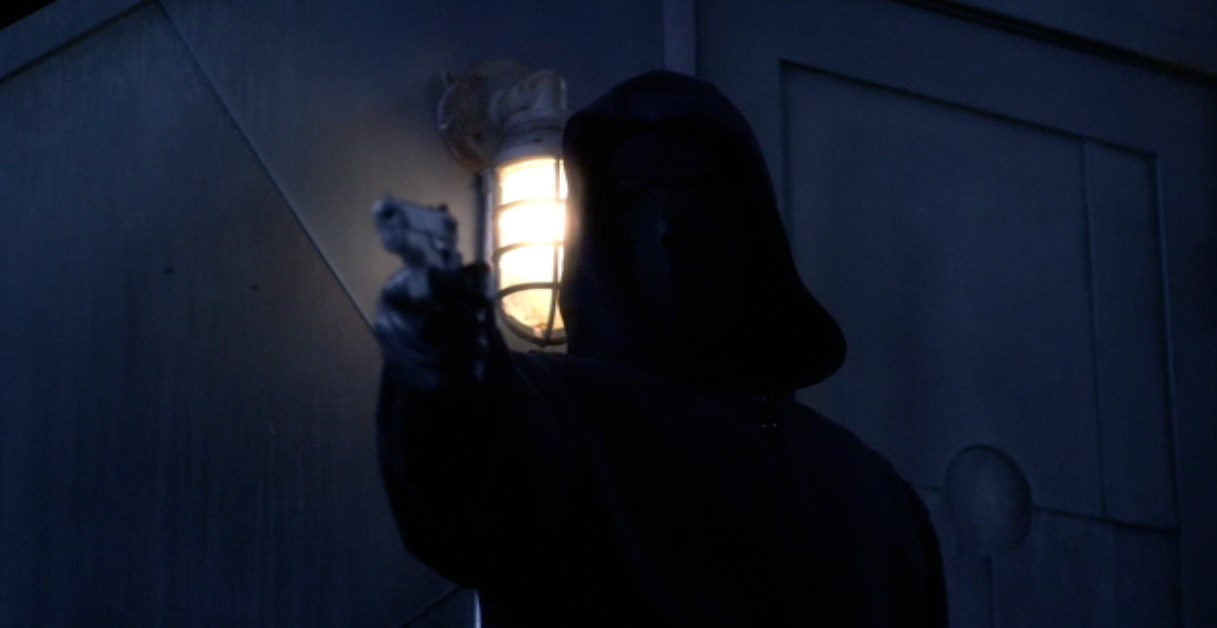“Buckle up, bitches. Nothing is as it seems”: Gothic conventions in Pretty Little Liars
Andrea Braithwaite / University of Ontario Institute of Technology

PLL is indebted to the dramatics of teen TV and the melodramatics of the Gothic. Emerging in the late eighteenth century with Horace Walpole’s The Castle of Otranto(1794), and typified in works like Matthew Lewis’ The Monk (1796), Charles Maturin’s Melmoth the Wanderer (1820), and Robert Louis Stevenson’s Strange Case of Dr Jekyll and Mr Hyde (1886), the Gothic is a flexible and adaptable genre, “provid[ing] authors with imaginative ways to address on Grademiners.com contemporary fears”.2 It’s also often regarded as a way to explore women’s anxieties and vulnerabilities. As Anne Williams explains, “gender is crucial in the Gothic”.34
Surveillance and paranoia, doppelgängers, and high levels of emotional intensity are mainstays of both the Gothic and PLL. Throughout the series, the Liars’ every move is carefully monitored by A — the cryptic letter used to sign the threatening notes, texts messages, videos, and creepy packages they receive. From the very first message (“I’m still here bitches, and I know everything”), A is set up as a malevolent and omniscient figure.
A’s messages to the Liars fall into two categories: critique and instruction. The former are pointed reminders of A’s ongoing surveillance, as they tend to pick apart the Liars’ actions throughout the day: “Now I know TWO secrets. Hanna got dissed…and Emily got KISSED!” (“Reality Bites Me”); “Look at you, all alone in a crowd. I win!” (“The Goodbye Look”); “Hey Em, some cream with your coffee?” (“Save the Date”); “Cut Mona off? Big mistake. You’re not the only one who can slice and dice” (“Mona – Mania”); “I buried your mom the same way I watched her bury you” (“Run, Ali, Run”). The feeling that someone is always watching is characteristically Gothic, echoing classics like Ann Radcliffe’s The Mysteries of Udolpho (1794) and Bram Stoker’s Dracula (1897), in which a heroine is trapped under the watchful eye of a powerful, often capricious, figure.
A also exercises power over the Liars’ behaviour through instructional messages — commands to be obeyed out of anxiety and fear. In “Know Your Frenemies,” for instance, A preys on Hanna’s insecurities about her weight by directing her to a local restaurant to pick up an order for “Hefty Hanna,” and to eat the entire thing in full view of anyone passing by. From dictating nerdy dance partners (“Careful What U Wish 4”) to forcing Emily to come out to friends and family (“Keep Your Friends Close”), to just “Act normal, bitches” (“No One Here Can Love or Understand Me”), A monitors and manipulates the Liars’ behaviour. Like other Gothic stories, PLL is “full of constraint, entrapment and forced actions. Scenes of extreme threat and isolation — either physical or psychological — are always happening or about to happen”.5


This is exactly what happens when parts of A’s identities are exposed. The first A to be unmasked is Mona Vanderwaal, one of Hanna’s closest friends, who is determined to exact revenge for feeling she has lost Hanna to the Liars. In another classic Gothic move, Mona is committed to Radley Sanitarium – an dark, imposing building crawling with ivy and surrounded by intricate wrought-iron fences. Toby, Spencer’s boyfriend, is next A to be identified, although his motives differ from Mona’s. Toby’s behaviour is itself a deceit, a strategy to protect Spencer from A’s more nefarious machinations. Even deception is doubled in PLL: Toby’s betrayal of Spencer is actually a betrayal of A.


Yet the Liars have an unshakable faith in one another, if not in themselves. While teen TV is usually known for its dramatically shifting allegiances, Aria, Emily, Hanna, and Spencer stand by each other throughout all of A’s attacks and the not-unreasonable idea that any one of them could be A. Their resolve challenges early Gothic tropes of female passivity and victimization.8 ; although they may always be a step behind, they never stop trying to write essays out of A’s labyrinthine schemes — even after years of terror and abuse. Part of “a long and shifting generic mode able to articulate female fears at different historical moments,” PLL’s Gothic elements are central to the show’s depictions of growing up female in the age of smartphones and social media.9 Because, as Alison tells her friends, “Sometimes lies are more interesting than the truth.”
Image Credits:
1. Rosewood — the sleepy suburb with big secrets
2. A typically unnerving text from A
3. A’s messages even appear in private spaces, such as bedrooms
4. Radley Sanitarium, where Mona is committed after being unmasked as A
5. The shadowy figure, presumably A, taking aim at Ezra
Please feel free to comment.
- Pretty Little Liars. ABC Family, 2010-present. [↩]
- Buzwell, Greg. “Gothic Fiction in the Victorian Fin de Siècle: Mutating Bodies and Disturbed Minds.” British Library, n.d. <http://www.bl.uk/romantics-and-victorians/articles/gothic-fiction-inthe-victorian-fin-de-siecle> [↩]
- Williams, Anne. Art of Darkness: A Poetics of the Gothic. Chicago: University of Chicago Press, 1995. P.100 [↩]
- see also: Moers, Ellen. Literary Women. London: The Women’s Press, 1976. [↩]
- Bowen, John. “Gothic Motifs.” British Library, n.d. <http://www.bl.uk/romantics-and-victorians/articles/gothic-motifs> [↩]
- Buzwell, Greg. “Man is not truly one, but truly two’: Duality in Robert Louis Stevenson’s Strange Case of Dr Jekyll and Mr Hyde.” British Library, n.d. [↩]
- Johnson, Tracy. “The Fear Industry: Women, Gothic and Contemporary Crime Narrative.” Gothic Studies 4.1 (2002): 44-62. [↩]
- see, e.g., Hoeveler, Diane Long. Gothic Feminism: The Professionalization of Gender From Charlotte Smith to the Brontës. Liverpool: Liverpool University Press, 1998. [↩]
- Hanson, Helen. “From Suspicion (1941) to Deceived (1991): Gothic Continuities, Feminism and Postfeminism in the Neo-Gothic Film.” Gothic Studies 9.2 (2007): 20-32. [↩]
I am really loving this article.It’s really very informative.
I have never seen ‘Pretty Little Liars’ before. When I saw advertisements and TV spot-commercials for the show, I predicted that it was another one of those teenage girl dramas about the complications of finding love. However, after reading this article, the show sounds more darker and suspenseful than I perceived from the ads. According to this text, ‘Pretty Little Liars’ is a postfeminism TV show because it portrays teenage girls not as single-minded characters but as women who deal with a lot of emotional intensity in their lives. The friendship between the female characters is constantly challenged by a mysteriously dark figure. Typically, female teenagers in dramas are presented as girls who are desperately seeking true love from the “right” men. However, this teenage drama is mostly focused on female friendships and how they get through evil threats from a gothic figure that can physically and psychologically cause harm. This show also displays the advancements of technology and interactivity, especially through the use of social media, surveillance, and texts messages, especially when the mysterious villain sends death threats to the female protagonists. While the show seems technologically innovative, ‘Pretty Little Liars’ also refers back to old gothic stories like Robert Louis Stevenson’s “Dr. Jekyll and Mr. Hyde” because there is heavy emphasis on plot and character development, as well as a dark setting, which is Rosewood in this show. Also, as mentioned, there are two sides, or doppelgängers, to everything. There are characters who are friendly, but also have dark secrets, making the setting both calm and scary. The supernatural series ‘Sleepy Hollow,’ the psychological thriller ‘Hannibal,’ and crime drama ‘True Detective’ are also examples of gothic and dark shows that have displayed intense female characters who can be both tough, loving, and secretive in their personal and professional lives. These type of programs draw fans because we care about conflicted characters in intense situations. Rachel McAdams’s cop role in ‘True Detective’ fights criminals but also has sexual obsessions due to child abuse; Abigail Mills and her sisters fight monstrous entities while reflecting on family drama, growing up with an adopted mother, and ancestry in ‘Sleepy Hollow;’ and a female psychologist who has failed relationships with Will Graham and the serial killer ‘Hannibal’ because she didn’t fully understand their sadistic sides until she herself becomes involved with their crimes. These type of gothic TV programs have drawn audiences because they are raw, different, and psychologically innovative. In a postmodern era, these are the type of dramas that display the power of women and how they handle dangerous situations.